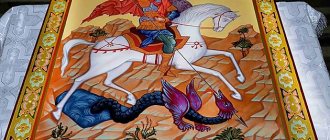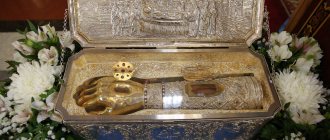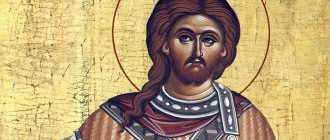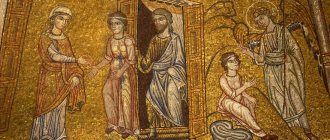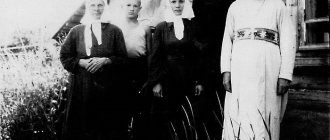It is difficult for a modern Christian to imagine that at the beginning of a new era many lives were laid down for faith in Jesus Christ, the Risen Savior. People were ready to go through cruel trials, endure torture with fire and iron, part with earthly existence, but remain forever alive in the Kingdom of Heaven.
For all generations, the holy martyrs remain an example of courage and faith, strengthening Orthodoxy in future centuries. Saint Eustathius Placidas, a great martyr of the second century, who was granted a meeting with Christ, like Job, endured all the trials, suffered martyrdom along with his family, but remained faithful to the Savior.
September 20 is the date of veneration of St. Eustathius in both Orthodoxy and Catholicism.
Brief historical information
It is known from sources that Evstateos was one of the first bishops of Syunik, the oldest region of Armenia, his ordination was performed by the apostles Thaddeus and Bartholomew.
Holy Martyr Eustathius Placidas
At the end of the first and beginning of the second century AD, the military leader Placidas faithfully served Emperor Titus and then Trajan. Living among idolaters, he was distinguished by kindness and mercy, helping the poor and needy.
Appearance of Christ
With good deeds and mercy, the military leader attracted the attention of the Savior; Christ personally appeared before Placida. Being a passionate hunter, the future saint chased a beautiful deer, almost caught up with it on a high mountain, when suddenly a light appeared in the antlers of the majestic animal.
In shining rays, a cross with the crucified Son of God appeared before the hunter. Like the Apostle Paul (Acts 9:4), Placidas heard the same voice: “Why are you persecuting Me?”
When asked who was speaking, the military leader heard that in front of him was Jesus Christ Himself, who died for the sake of the eternal life of people and endured voluntary suffering. Christ emphasized that, not knowing the Savior, Placidas does good deeds, and therefore the Lord chose the stratelate for salvation in eternity.
The military leader instantly accepted Christ as his Savior and asked Him to teach him what to do next. God's voice told me to go to the priest and receive Baptism. In great joy, Placidas returned to his home, where he was met by his wife Tatiana, who was waiting for her husband to tell her dream.
Important! In the dream, a voice told the woman that the next day her entire family, including her husband and children, would accept Christianity, knowing a loving God. After Placidas' story about meeting Jesus, the family visited a Christian presbyter, received baptism and communion.
After baptism, Placis began to be called Eustathius, his wife Theopistia, and his children Agapius and Theopist. Returning to the holy mountain, the newly converted Eustathius praised the Creator with fervent prayers and thanked the Savior for his salvation. Stratilates was again given the grace to hear the Divine voice, which warned the military leader about impending trials and sorrows.
All this will be allowed by the Creator in order to ultimately accept the Great Martyr and his family into the Kingdom of Heaven and place on him the Crown of Salvation. Eustathius humbly accepted the message from Heaven, asking for one thing, that God’s help be with the martyrs.
Trials and Faith
Christian life of St. Eustathia began with a pestilence of livestock, servants and complete impoverishment. In humility and poverty, the family, which had never known hardship, left the house and boarded a ship bound for Egypt. The beauty of the military leader's wife struck the captain of the ship; he forcibly landed the saint and his two sons on the nearest shore, leaving the woman with him.
Before he could recover from the shock, the traveler experienced new grief. A stormy river became an obstacle on the path of the father and young sons. While the saint was carrying one son to the other side, the younger one was dragged away by a wolf.
Icon of Saint Eustathius Placidas
Upon his return, Eustathius discovered that the eldest had also disappeared, having been carried away by a lion. Only remembering the words of Christ, Placida found strength in himself and moved on. He clearly knew that God was with him, these trials were sent to test faith, humility and patience.
Stratilates believed that the Lord was next to him, and everything that had been taken would be returned. Only faith gave him the strength to live on. For 15 long years, not knowing that trouble had passed over his loved ones, the saint worked as a worker in the village of Vadiss.
By the grace of the Lord, his sons were saved by shepherds and farmers. The shipman was struck by a fatal disease even before he wanted to touch the beautiful woman.
Return to Rome and family reunification
Emperor Trajan suffered defeat after defeat during one of the wars, he remembered the experienced military leader and ordered to find him.
The friends of the stratilate, Antiochus and Acacius, traveled through many places until they came to Vadis. The great martyr guarding the bread in the field immediately recognized his friends, but they did not recognize him when they met. The soldiers explained to the guard the purpose of their visit and went with him to the owner’s house, where they were fed. Noticing a scar on the worker’s neck, they immediately remembered that their commander received this mark in battle, and recognized him.
Returning to Rome, Placidas stood at the head of the army, training new recruits, not even suspecting that his sons were among them. The young warrior friends were distinguished by their dexterity and courage, not knowing that their own father was placed in charge of them, and they were siblings.
Theopistia did not doubt for a moment the future meeting with her relatives, she did not know that the children were kidnapped by animals, that her husband had become a simple worker, she simply believed in the Lord. Living in a foreign country, she accidentally witnessed a meeting of warrior friends.
Icon of Eustathius Placis, wife of Theopistia, children Agapius and Theopist
By chance, the friends were talking in a tent, telling each other about their lives; comparing what was told, they realized that the Lord had granted a meeting to their siblings.
Their conversation was heard by their mother, she was embarrassed to appear in front of the rich warriors in her rags, and went to the military leader to ask him to take her on a campaign. The couple recognized each other at first sight, cried for a long time and announced the good news to the brothers.
Rome greeted the army with honors and glory after another victory. At that time, the deceased Emperor Trajan was replaced by the ardent idolater Adrian; he ordered the preparation of sacrifices to idols and the presence of all soldiers and residents of the city. At the ceremony it turned out that the hero of the occasion was absent. The emperor was indignant that the military leader did not want to thank the gods for their support, to which he heard stunning news.
Fidelity to Christ and martyrdom
The saint publicly recognized himself and his family as Christians, declaring that he gives all gratitude for the salvation of his family and victory in the war to the Living God, the Savior, Jesus Christ.
The enraged emperor instantly demoted the military leader, ordering the holy family to be taken into custody, tortured and forced into idolatry. Having failed, the court ordered the martyrs to be torn to pieces by hungry beasts.
Interesting! The behavior of the terrible lions shocked the audience; the animals literally licked the hands of the condemned men, lying down like cats at their feet. Many citizens believed in Christ, not being afraid to accept death for true faith.
In a rage, the emperor ordered a copper bull to be prepared, heating the metal red-hot, where the prisoners were thrown. The crowd did not hear the cries of the martyrs, for the Lord granted them eternal sleep, keeping their bodies intact. The wife of Saint Theopistius, the sons Agapius and Theopist lay near the Great Martyr Eustathius with illuminated faces, a joyful smile played on their lips, and not a single hair was damaged by the fire.
The bodies of the saints were buried with dignity, even the emperor did not dare to oppose this.
Olesya Gladkova: “The Life of Eustathius Placidas formed the paradigm of Russian princely holiness”
How ancient hagiographical works were created, how they influenced the worldviews of medieval people, why modern lives have lost their literary value, how a modern researcher is being strangled by the “ruble” and whether there are prospects for ancient Russian textual criticism, a candidate of philological sciences, doctoral student at the IMLI RAS, author of works on history tells us and textual studies of ancient Russian literature, author of a monograph dedicated to the “Life of Eustathius Placis” Gladkova Olesya Vladimirovna.
***
Olesya Vladimirovna, a few words about your work on the study of the life of “Eustathius Placida”, why were you interested in this hagiographic work?
The study of the Life of Eustathius Placidas began for me in my distant student years, that is, approximately in the late 70s - early 80s. last century. Our teacher of ancient Russian literature, Professor Nikolai Ivanovich Prokofiev .
I remember I came to his hospitable house on Mira Avenue, always open to students, graduate students, as well as more “mature” students and colleagues, and asked him to advise me on some topic for work in the circle of ancient Russian literature that he led . I said that I wanted to do translated hagiography, having at that time rather vague and romantic ideas about it.
The life of Eustathius Plakida, as I understand it, had long attracted the attention of Nikolai Ivanovich, who towards the end of his life was especially looking for informal manifestations of kindness, gentleness, sincerity and, of course, talent in ancient Russian literature.
As I learned a little later, I was not the first to whom Nikolai Ivanovich offered this monument for study; my predecessors, at first, may have been more successful in some ways than me - I could understand this from the brief remarks of my Teacher - but then life led them away from scientific pursuits.
The monument did not work for me. I wrote a bad coursework and a bad thesis, for which the kind Nikolai Ivanovich gave me “A’s.” Thanks to him, it was an advance for many years to come. The candidate's dissertation (1993), written under the guidance of Nikolai Ivanovich, was somewhat better. The dissertation was based on textual research: without studying the manuscript tradition, further study of the Life was impossible.
Great Martyr Eustathius Placidas
My supervisor especially insisted on attention to lowercase and superscript characters, which are usually omitted in modern editions of handwritten texts and are partly replaced by modern punctuation. We did not yet know what was behind these signs; at first I only patiently copied them, following the advice of my Teacher and intuitively understanding the importance of such work.
At that time, I knew 105 lists of the monument, which, nevertheless, remained incomprehensible to me. A lot of time passed, it took a lot of effort, and not only mine, before I began to understand this work and saw its deep meaning, expressed, in particular, in the wonderful rhythmic organization, contained, among other things, in those very initially incomprehensible signs of the manuscripts which I copied.
Great Martyr Eustathius, martyrs Theopistius, Agapius, Theopist with their lives. Icon, 18th century
I think that in those distant times, when we were choosing a topic for my student work, even Nikolai Ivanovich, gifted with a subtle sense of words and amazing research intuition, could not imagine that the Life of Eustathius Placidas, which touched him, first of all, with the special touchingness of the main character and the plot, inherited from the novel of antiquity, hides meanings that bring this ancient monument closer to the greatest works of world literature, such as, for example, Dante’s or Goethe’s .
How can you determine the genre of this life?
Even the Bollandists and domestic pre-revolutionary scholars defined the genre of the Life of Eustathius Placis and similar lives influenced by the ancient novel as a “pious novel” , “Christian novel”, “life-novel” . Nikolai Ivanovich, after listening to my next student report, proposed to dwell on the term “ hagiographic novel Vladimir Vladimirovich Kuskov later liked this definition .
Textbook of Professor V.V. Kuskov
Of course, in the Middle Ages, no one defined the Life of Eustathius in this way, which, of course, was perceived as a life and was included in the Chetya Menaion, Solemnity and other Chetya collections. The reading of the Life was prescribed by the Charter on September 20, the day of remembrance of saints (according to the old style).
What images, symbols, and twists and turns of this life do you think have not only literary, but also historical, spiritual and philosophical implications? What new facts emerged during your study of the Life of Eustathius Placis?
Let's start with the fact that all the images and twists and turns (plot) of the Life were perceived by the medieval reader as historical, that is, real. The hagiographer did not invent anything; he reproduced what was already “written in heaven,” as they said in the lives. This required enormous spiritual experience. The hagiographer reproduced the “ideal truth” ( Bicilli ) about the saint, which did not always correspond to the “real truth.”
Pyotr Mikhailovich Bitsilli (1879-1953) - Russian historian and literary critic, professor at Novorossiysk and Sofia universities. Known for a number of discoveries and development of scientific hypotheses in the field of spiritual and religious culture, symbolism and hierarchy of medieval man
The early lives contained at least three levels of meaning: concrete-event , addressed to the profane, didactic , understandable to a more or less literate audience, and mystical , intended for the monastic and princely enlightened and initiated elite.
I have written more than once about the three meanings in hagiography; in my monograph dedicated to the Slavic translations of the Life of Eustathius Placidas, I analyze in detail all three semantic levels of this monument, the early texts of which were characterized by the fusion of “called” and “naming”, that is, the word and that object, action, etc., which it called.
Thus, on the third, mystical, level, in the absence of time, Christ and the word “ Christ ” denoting Him, and Eustathius, similar to Christ, all united in Christ and there was one Christ, which was an unthinkable blasphemy on the first two levels of meaning, where there was time.
It is very difficult for a modern reader to understand such a text.
Vision of the Great Martyr Eustathius Placis. Baptism of Placidus and his family, kidnapping of his wife. Byzantium, XI century
As a rule, the modern reader perceives only the first two levels, which greatly simplifies life. It should be noted that not all lives have such a complex and developed hierarchy of meanings. Both in the original and in translation, the Life of Eustathius Placidas was written for the elite, and St. himself belonged to the elite. Eustathius, who is known to have been the favorite military leader of the emperor ("king" in Slavic texts) Trajan.
Statue of Emperor Trajan
You can read more about all levels of meaning in the Life of Eustathius Placidas in my just published monograph dedicated to the Life. Now I will just say once again that this monument, which tells about the fate of the new Job , who survived the Epiphany, brilliantly tells about a terrible, irreconcilable struggle between the forces of good and evil in which a person is drawn.
What other ancient texts have you worked and are working with?
The Life of Eustathius Placidas was a practically unstudied work, so literally every fact discovered during the research process was new. For example, such a large number of Slavic translations that arose in the 9th-17th centuries was a complete surprise to me. - eleven.
Unexpected, for example, was such a significant role of the Life in the formation of the paradigm of Russian princely holiness: Eustathius Placis - Constantine the Great - Vladimir the Saint (more precisely: Constantine the Great - Eustathius Placis - Vladimir the Saint, because, despite the fact that Eustathius lived before Constantine, his Life was written later), although assumptions about the existence of this model were made earlier.
For the first time, the significant influence of the Life on works of original Russian literature was revealed - on the Tale of the Theodore Icon of the Mother of God, on the Tale of King Haggai, possibly on the Tale of Peter and Fevronia of Murom and many others.
Legendary King Haggai
The study of the lists of the Life has allowed us to take a largely new look at the history of the most famous handwritten collections (for example, the Sylvester collection , the famous Russian parchment manuscript of the turn of the 14th-15th centuries), monastery libraries, the history of Old Believer book literature and culture, and so on. Basically and above all, these are early hagiographical monuments, translated and original - the Sinai Patericon, the lives of Theodosius the Great, Constantine-Cyril the Philosopher, Isidor Tverdislov, the Holy Fool of Rostov, Peter and Fevronia of Murom, etc.
I also have works devoted to the connections between medieval literature and modern literature - the Life of Eustathius Placida and the novel by the Serbian postmodernist writer Milorad Pavic (the topic is reflected in the monograph), The Tale of Abba Gerasim and the Lion and the legend of N. S. Leskov “The Lion Elder Gerasim"; plots of ancient Russian literature in modern literature for children, connections between literature and art in Ancient Rus', and so on.
Serbian writer Milorad Pavic is very popular among modern Russian readers
I cannot consider my work on the Life of Eustathius Placidas completed, since many of his copies remain inaccessible to me for reasons beyond my control. For example, for many years the Synod fund with its richest manuscript collection (Russian State Historical Archive, St. Petersburg) has been closed to readers, and some foreign ancient repositories remain inaccessible to me.
I would also like to move forward in studying the history of the text of the Life of Isidor Tverdislov, work on which I began in the late 90s.
I also have very secret dreams, but I will keep silent about them for now.
As you can see, the work of a medievalist related to the study of manuscripts cannot be done quickly.
Modern texts of hagiographic literature are similar to short biographical notes, unlike the ancient ones. Why do you think the hagiographic genre has lost its literary quality, and what is the reason for this?
“Times change, and we change with them.” The loss of literature in the hagiographic genre is associated with many reasons - with a change in worldview, first of all, with the rejection of the symbolic vision of the world characteristic of the period of early Christianity, with the emergence of the personal principle, and with it secular literature, with the solidification of the canon, with certain changes in life Churches and so on.
This is a very complex question, the answer to which requires the use of extensive material. To some extent, I tried to answer it in my monograph. I believe that the last hagiographer in the medieval sense and at the same time the person who quite consciously put an end to classical medieval hagiography was Demetrius of Rostov .
Is there a future, in your opinion, in publishing not only in printed books, but also on the Internet primary sources - digitized originals of ancient manuscripts for subsequent study or simply reading by ordinary users?
Of course, there is a future, but how could it be otherwise? Digitizing our richest (so far and still) collections is simply the first thing that needs to be done. This process is going on all over the world. Let everyone who wants to read the manuscripts, study our national heritage, which is sometimes so carefully guarded from the people that even a researcher armed with relationships, petitions and all kinds of petitions cannot see the manuscript. Just imagine that the list of the Lay of Igor’s Campaign would have been digitized, in which case the fire of Moscow would not have destroyed it. Manuscripts, unfortunately, burn, deteriorate, are stolen, lost, and so on. At the same time, manuscripts cannot be hidden, they must be read, studied, they must be accessible to both the researcher and the ordinary reader, no matter where these people live - in capitals, in large cities, or far from them.
Unfortunately, often in our archives it is very difficult and very expensive, and sometimes almost impossible, to obtain a digital copy of even one manuscript (what is a manuscript - a copy, or at least a few sheets from it!), although for simple digitization all you need is a good camera and computer. And doing this, as shown, for example, by the experience of translating the Collection of the Trinity-Sergius Lavra (RSL) into digital form, is now quite possible.
Interviewed by Marina Voloskova
Reverence
In Orthodoxy and Catholicism, many churches were erected in honor of Saint Eustathius Placidus in the Christian world, one of the first was erected in the 7th century, but gained fame in the ninth century, this is the temple in Rome.
In eastern Georgia there is the Ertatsminda Temple. This name comes from the word “estatecmind”, that is, Saint Eustathius, who to this day is the guardian angel of the Georgian king, the holy martyr Luarsab the Second.
Temple of Eustathius Placis in Ertatsminda, Georgia
The great commander Giorgi Saakadze also considered the military leader Placidus the patron of the Georgian army. Thanks to the intercession of the great martyr, the Georgians won the battle of 1609 against the Turks; after the victory, the grateful warriors bowed their banners before the icon of the stratelates.
Eustathius-Placidas is revered in Rus' in the form of a warrior-martyr; he is often compared to the great Constantine the Great.
The Baptist of Rus', Vladimir the Great, was named by Nestor as the new Estathius-Placida, in whose honor the grandson of Prince Vladimir, the son of Mstislav of Chernigov, was named.
The Tatev monastery complex, which has survived until the present century, was built over the saint’s grave, on the site of a church.
Sint Eustatius is an island in the Caribbean, named after the great martyr Evstatheos.
Prayers
O glorious, holy and long-suffering great martyr of Christ Eustathius! Hear us, sinners and unworthy, who celebrate your holy memory. Ask us from the Lord with your many-powerful prayers for grace, even for salvation, and for all the sins we have committed, forgiveness, prosperity of the earth, a peaceful dispensation for the world and freedom from the fierce wiles of the devil, the Christian end of our life and the peaceful passage to heaven through airy ordeals, you You have received this grace from the Lord to pray for us, and if you desire help for us who honor your sacred memory, you can do everything. Do not despise us, unworthy, passion-bearing saint, and ask from the Lord all that is good and useful to our souls, so that we too may be worthy to glorify and glorify His all-holy and magnificent name in the worldly Kingdom of Heaven, where there is the dwelling place of all saints, forever and ever. Amen.
